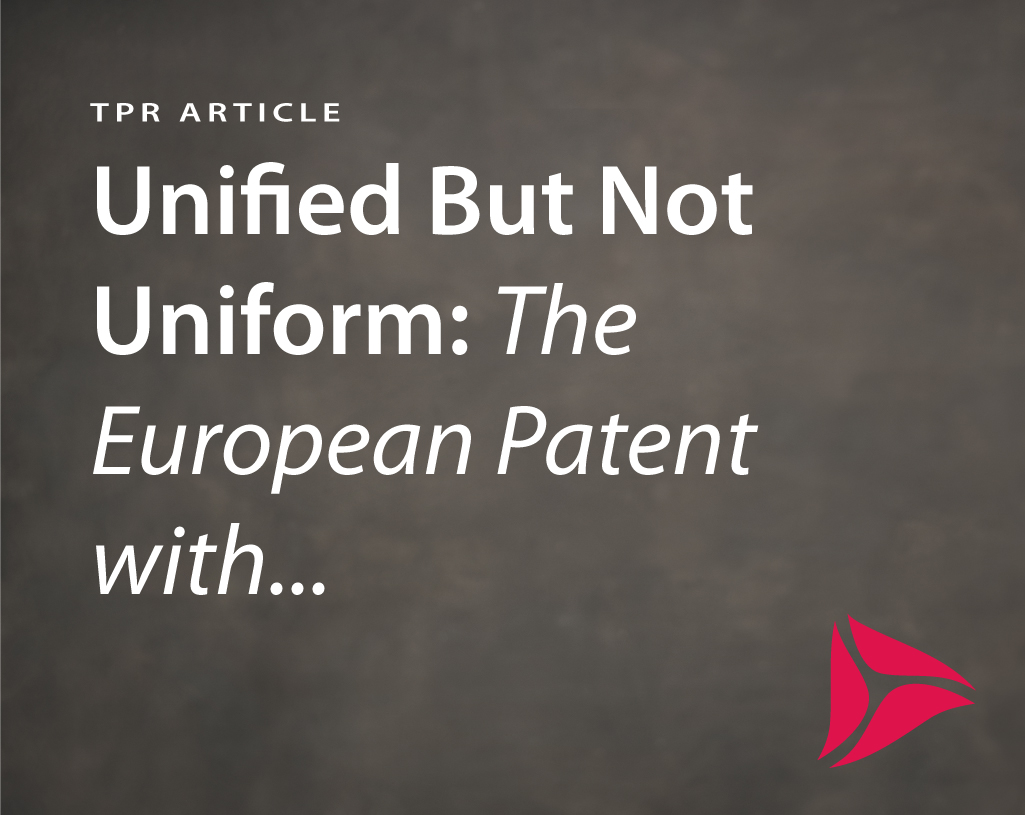Nearly 3 years have passed since two European Union (EU) regulations entered into force, paving the way for a new route to managing patent rights across Europe. Those charged with the formation of the proposed Unified Patent Court (UPC) have supervised the production of 18 draft versions of its Rules of Procedure, hosted numerous seminars, created dedicated websites, conducted mock trials, consultation rounds and social media discussions. But time is running short, and the issues facing the recording and disclosure of unitary effect are no less complex than those involved in creating and litigating it.
The first point which needs to be made is that the so-called Unitary Patent is not, in fact, a new patent at all. It merely represents a change in the post-grant management of the patent rights emanating from the European Patent Office (EPO). Once a European Patent has been granted, the proprietor will be able to request that their rights are treated as a single package for the purposes of renewal, post-grant amendment, re-assignment or litigation, instead of as a bundle of national patents. As a consequence, unitary effect will probably not be documented as if it was a distinct new member of a patent family, but merely as a change in legal status of a European Patent. The EPO Register will be the authoritative source for information on whether unitary effect has been granted for each specific case.
Secondly, it is optional. No-one will be obliged to use the new system. If proprietors feel that they are content with the current system, they can continue to use it without change. This means that, once the new system is open for business, the patent rights issued by the EPO will exist in either – or both! – of two different legal forms. Some patents may never be registered for unitary effect. For those which are registered, there is a further complication, because thirdly, it does not affect rights across the whole of Europe. The rights embodied in a single granted patent will split into two parallel tracks – some validated nationally and other parts being treated trans-nationally as a unitary right across multiple EU states.
The distinction arises because “Europe” is not a uniform entity; several different institutions and legal agreements define its borders. The unitary effect regulations are promulgated by the EU of 28 members, not the EPO with its 38 members extending far beyond the EU.
One of the most confusing aspects of the system is that, fourthly, the extent of the unified patent rights will vary, according to when the application for unitary effect is made. Patent owners have only a 1-month window, in the period immediately following grant, to apply for unitary effect. Once that window closes, no changes can be made to the geographical extent of unitary effect. This would not be an issue if all the states entered the unitary effect system simultaneously, at the beginning. Unfortunately, this will not happen – in all likelihood, they will gradually filter in over a period of several years.
The key controlling factor is the separate legal agreement creating the UPC. Unless the UPC Agreement is in force in a member state, that state will not be eligible for inclusion in a unitary effect registration. The Agreement will enter into force, and fire the starting gun for the whole procedure, when a minimum of 13 states have ratified it. As a consequence, the very earliest applications will only affect the legal status in respect of those early states.
This means that the 38 member states which may appear in the designation list of a granted EP will have to be considered as no fewer than 5 different groups:
- Group 1; EPO member states which are not members of the EU – these patent rights will never be affected by the unitary regulations and must continue to be validated individually (currently 10 states);
- Group 2; EU member states which are not participating in the unitary effect system – these rights will also continue to be validated individually, unless the states decide to join later (currently Croatia and Spain);
- Group 3; EU member states which have not signed the UPC Agreement – these rights are ineligible to be treated for unitary effect, so must be validated individually (currently Poland);
- Group 4; EU member states which are participating in the unitary effect system, and have ratified the UPC Agreement – these rights are eligible to be registered for treatment as a single unitary patent (initially a minimum of 13 states, which must include France, Germany and the United Kingdom);
- Group 5; EU member states which are participating in the unitary effect system, but have not yet ratified the UPC Agreement – these rights are not eligible to be registered for treatment as a single unitary patent, and must be validated individually, until each country completes the ratification process and moves into Group 4 (initially this could be as many as 13 states).
There is also a 6th group – the extension states of Bosnia-Herzegovina and Montenegro and the validation states of Morocco and Moldova – which are unaffected by the EU legislation and must also be validated individually.
As a result, unless the 10 EPO non-EU states (which include a number of important economies such as Switzerland and Turkey) all accede to the EU; unless Poland signs the UPC Agreement; and unless Spain and Croatia join the other 26 EU states in the procedure and become bound by the EU Regulations, then the management of patent rights emerging from the EPO in the coming years will continue to involve a complex hybrid of procedures.
© 2016, Technology & Patent Research International, Inc.


